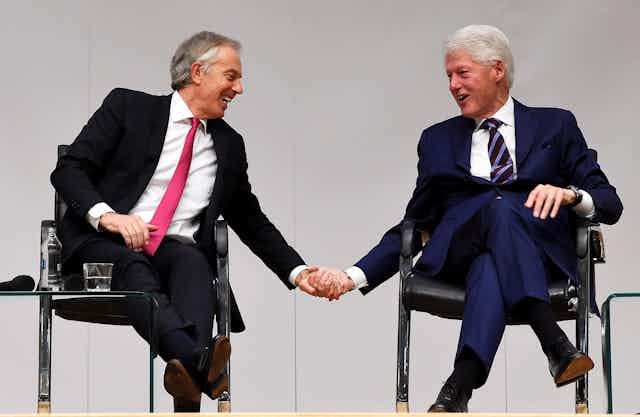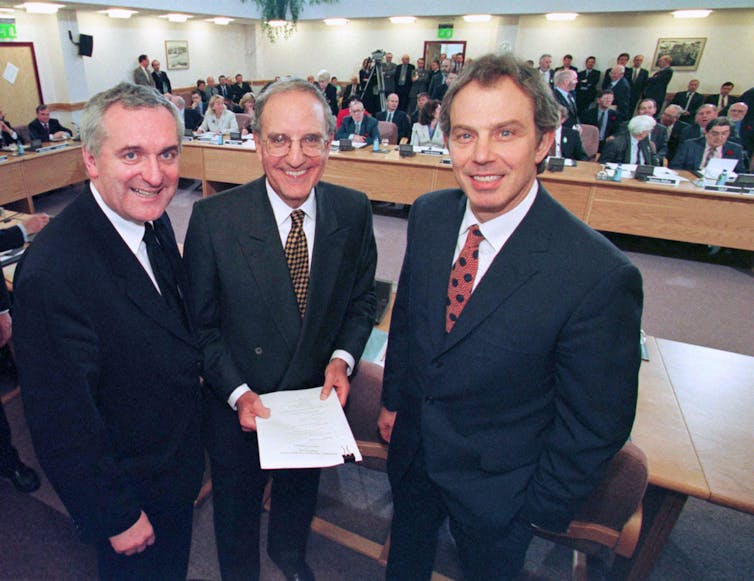

Peter John McLoughlin has received funding in the past from the AHRC, Leverhulme Trust, the Irish Research Council, and the Fulbright Commission. He is a member of Greenpeace.
Queen's University Belfast apporte des fonds en tant que membre fondateur de The Conversation UK.
Voir les partenaires de The Conversation France
Between 1820 and 1920, four million people emigrated from Ireland to the US. Many were fleeing hunger and destitution and so brought with them an “exile” nationalism – a conviction that they were forced to leave by British misgovernment and exploitation of Ireland. Little wonder, then, that the Irish diaspora in the US played a crucial role in supporting, and particularly financing, the struggle for Irish independence.
When the Northern Ireland conflict broke out in the late 1960s, Irish America again mobilised in support of the region’s nationalist minority community. The diaspora saw the conflict in simplistic terms, as a renewal of the fight for Irish freedom from British imperial domination.
Events like Bloody Sunday in January 1972 – when British troops shot dead 13 civil rights protesters in Derry – understandably reinforced such views. As a result, money and even arms (more easily acquired in the US) began to flow across the Atlantic and into the IRA’s hands. In this period, therefore, Irish American actions only contributed to further bloodshed in Northern Ireland.
By the 1990s, the diaspora was playing quite a different role, one which was crucial to the region’s peace process and the 1998 Good Friday Agreement. There were various reasons for this. Firstly, more sensible voices had emerged in Irish America. Instead of supporting the IRA, or advocating a British withdrawal and the reunification of Ireland, they pressed for radical reform that would achieve real equality for the nationalist minority.
Secondly, with the fall of the Berlin Wall, the global picture had drastically changed. Previously, the White House had largely avoided commenting on Northern Ireland. The US relied on the British government to contain the communist threat in Europe and would not risk offending it for fear of losing that support. But with the collapse of the Soviet Union, president Bill Clinton did not need to worry in the way that his predecessors did about damaging the Anglo-American “special relationship”. He thus listened to those in Irish America who argued that the White House should play a role in the peace process then emerging in Northern Ireland.
Most controversial was Clinton’s decision in January 1994 to give Gerry Adams a US visa. This came at a time when the IRA was still bombing Britain, and the Sinn Féin leader was seen by most people as an apologist for republican violence. The British government was outraged by Clinton’s decision, and John Major refused to take his calls for some time afterwards – a undeniable rarity in US-UK relations. However, when the IRA called a ceasefire six months later, Clinton appeared to be vindicated. Giving Adams a US visa had allowed the Sinn Féin leader to demonstrate to the IRA the gains that could be made by adopting a purely political strategy.
Clinton then sent a trusted confidante, the recently retired US senator, George Mitchell, to chair peace talks in Northern Ireland. Mitchell managed to steer discussions in which some parties still refused to directly address one another, and instead communicated only through him as chair of the talks. His patience was phenomenal, and Mitchell played a major role in bringing about the Good Friday peace settlement.
After Clinton left office in 2001, the George W. Bush administration helped in the difficult process of implementing this accord. The IRA still refused to decommission its weapons, but pressure from the US – which, after 9/11, showed no tolerance for anything that might be seen as terrorist activity – helped force it to do so. Similarly, the Bush administration pushed Sinn Féin towards accepting reformed policing arrangements in Northern Ireland.
In Irish America, figures like Ted Kennedy, who had been crucial in bringing Sinn Féin into the peace process, now insisted that it accept all the rules of the new political order. Even the hardline unionist party, the DUP, was impressed, and was eventually obliged to share power with Sinn Féin.

Thereafter, the US played a limited role in Northern Ireland – until Brexit. The UK’s departure from the EU created significant challenges in managing the Irish border, and thus posed a threat to the Good Friday Agreement as it is generally considered a hard border on the island of Ireland would go against the spirit of the deal. Irish America responded by reorganising and lobbying to protect the accord. Even when running for the presidency in 2020, Joe Biden – fiercely proud of his own Irish heritage – famously tweeted a warning to the UK: “We can’t allow the Good Friday Agreement that brought peace to Northern Ireland to become a casualty of Brexit.”
After Biden’s election, pressure from the White House undoubtedly helped steer Boris Johnson towards a Brexit deal which prioritised peace in the region.
This also explains why Biden will be visiting Northern Ireland to mark the 25th anniversary of the Good Friday Agreement. The US government, and Irish America, both feel that they helped create peace the region, and want to preserve and celebrate this achievement.